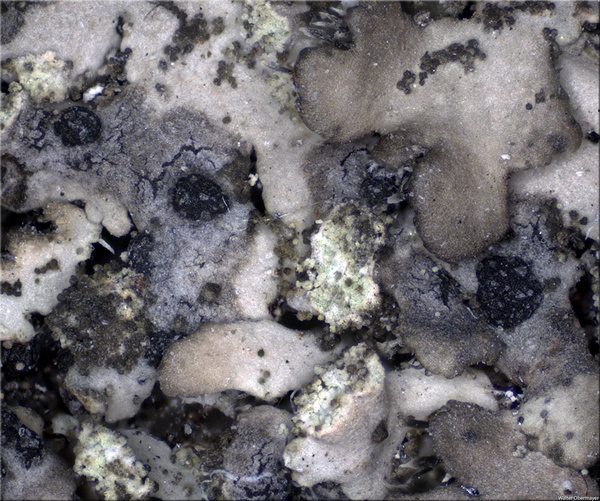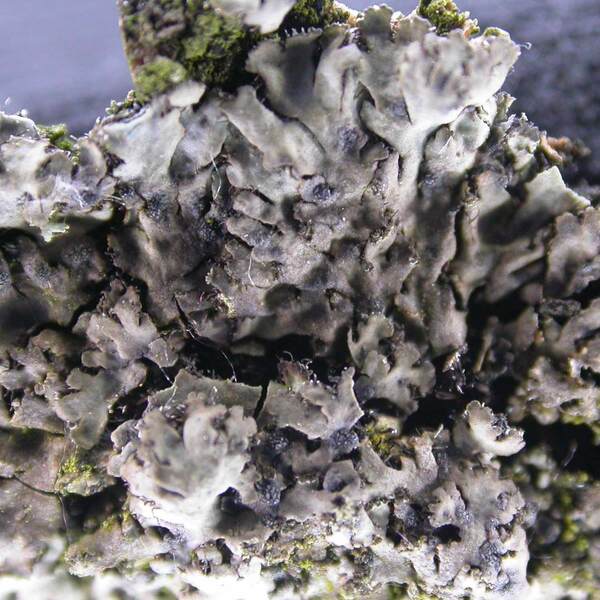Arthonia phaeophysciae Grube & Matzer
Bibl. Lichenol., 68: 10, 1997.
Synonyms: Bryostigma phaeophysciae (Grube & Matzer) S.Y. Kondr. & J.-S. Hur
Distribution: N - Frl (Brackel 2013), TAA (Ravera & al. 2023b), Emil (Brackel 2025). C - Umb (Brackel 2025), Laz (Herb. von Brackel 404).
Description: Thallus inapparent, not lichenized, the hyphae developing inside the thalli of Phaeophyscia-species; strongly infected parts of the hosts become necrotic and blackened and may be covered in thallospores of the parasite. Apothecia arthonioid, emarginate, breaking through the upper cortex of the host, more or less round, 0.1-0.3 mm across, with a black, sometimes grey-pruinose (remains of the epinecral layer of the host), flat to slightly convex disc, without a proper margin. Proper exciple poorly developed; epithecium pale olive-brown, 10-25 µm high; hymenium colourless, 30-40 µm high, I+ red, K/I+ bluish then reddish; paraphysoids branched and anastomosing, vertically oriented, 2-3 µm thick; hypothecium colourless to pale brown, 20-25 µm high, K+ grey. Asci 8-spored, broadly clavate to subglobose, semi-fissitunicate, with a large, non-amyloid apical dome, a distinct ocular chamber, and an amyloid ring-structure in tholus, Arthonia-type. Ascospores 1-septate, very slightly constricted at septum, hyaline, obovate, 12-14 x 4-6 µm, with a gelatinous epispore. Photobiont absent. Spot tests: K-, C-, KC-, P-. Chemistry: without lichen substances. Note: a lichenicolous fungus, commensalistic or weakly parasitic on the thalli of Phaeophyscia-species, especially P. orbicularis; perhaps more widespread throughout Italy, at least in the North, below the subalpine belt; the species, however, seems to be rare south of the Alps, (von Brackel in litt.).
Growth form: Lichenicolous fungus
Substrata: bark
Reproductive strategy: mainly sexual
paras Phaeophyscia spp.
Commonnes-rarity: (info)
Alpine belt: absent
Subalpine belt: absent
Oromediterranean belt: absent
Montane belt: very rare
Submediterranean belt: rare
Padanian area: extremely rare
Humid submediterranean belt: absent
Humid mediterranean belt: absent
Dry mediterranean belt: absent

Predictive model
Herbarium samples
Growth form: Lichenicolous fungus
Substrata: bark
Reproductive strategy: mainly sexual
paras Phaeophyscia spp.
Commonnes-rarity: (info)
Alpine belt: absent
Subalpine belt: absent
Oromediterranean belt: absent
Montane belt: very rare
Submediterranean belt: rare
Padanian area: extremely rare
Humid submediterranean belt: absent
Humid mediterranean belt: absent
Dry mediterranean belt: absent

Predictive model
| Herbarium samples |
 INDEX FUNGORUM
INDEX FUNGORUM
 GBIF
GBIF
 DOLICHENS
DOLICHENS



